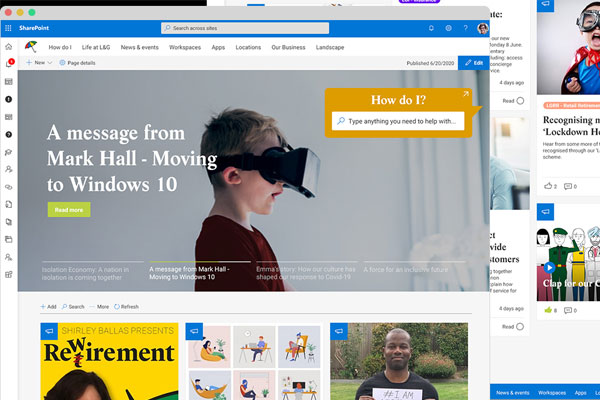
SharePoint is the most common base technology for an intranet and it’s no surprise that many organisations choose to use it for their intranet project. However, before undertaking a project to build a SharePoint intranet, it’s important to plan properly and consider the different aspects of your build.
No two SharePoint intranets are the same – and that also means no two SharePoint intranet projects are the same. You need to consider your particular needs, your resources and a range of supporting factors that will determine the detail behind your project. In this post we’ve created ten high-level, critical questions that every team building a SharePoint intranet should consider before diving headlong into a project.
Of course, there are a stack of related questions as well as more granular detail that also need to be considered, but we hope this article serves as a starting point for project planning.
1. What is my intranet trying to achieve?
The first question you usually need to ask is what your new SharePoint intranet is trying to achieve. Is it replacing an old intranet? Which key organisational processes is it supporting? How is it contributing to our company strategy? What are the more detailed objectives for the new intranet
These high-level questions and more are usually addressed in an intranet strategy – effectively a plan for your new intranet, what it sets out to do and how you’re going to deliver it. Then more specifically, they may be addressed in the different requirements for intranet features. There may be a need to make a business case to – but ultimately all these outputs all stem from working out what your intranet is trying to achieve.
2. Do I understand the needs and pain points of my users?
A SharePoint intranet is there to meet the needs of users to help them stay informed and get things done, as well as resolve any associated pain points. But if you don’t have a good understanding of what employee needs and pain points are, and what these are for different groups across your workforce, then it’s going to be very difficult to build an intranet that has value and sustainable adoption.
The only way to understand the needs of your users is to have gone through a discovery exercise and undertaken user research. An intranet cannot be built on assumptions – if you haven’t got that thorough understanding then you’re not ready to build your SharePoint intranet. At Content Formula, user and stakeholder research undertaken during a discovery phase is a core part of our methodology when we work with our customers.
3. Are my business stakeholders behind the new intranet?
Because an intranet touches every part of an organisation and also involves many different teams and functions in its day to day running, it is important to get the backing of all the key business stakeholders for your project. These usually include HR, IT, Communications, Knowledge Management, different lines of business and your leadership function. It’s also important to ensure you have buy-in from any legal, risk and compliance teams who can identify any risk-related issues about the intranet early.
Having buy-in from everybody across the business and getting consensus on your intranet strategy will help for a smoother and trouble-free roll-out, as well as a better intranet.
4. Who is responsible and accountable for the new intranet?
Effective governance is a must-have for a successful SharePoint intranet if you want to ensure it has strategic direction, effective and efficient management, and up-to-date and valuable content. While a lot of the specific governance will likely be worked out during your project phase, it really helps to know upfront who is going to be responsible and accountable for the new intranet. This usually involves working out the ultimate owner, but also the split of responsibilities between IT, internal communications and any other teams. This split will help to define and influence areas such as a business case, project roles and even influence the features that you might include on the intranet.
5. Who is on the project team to build the new intranet?
Before you build your SharePoint intranet and instigate the project, you’ll need to define the project team who are going to be responsible. This will be linked to the answer to the last question – who is going to be responsible and accountable for the new intranet.
Who is going to be the project sponsor? Who are going to be the core team working on the project? Who is going to be the business lead and effectively the technical lead? Which functions are going to be represented in that team? Which functions and people might take an important but more peripheral role in the project?
In assessing the project team, their relative experience and the resourcing available, you’ll also start to get a good idea of the extent to which you’ll need to rely on external resources for help. You may need to get some intranet consultancy on a range of different matters, or you may even need to hire for an experienced contractor to come in and play a leading role in the project.
6. Which content are we migrating?
It will also help to know if you are going to be migrating any existing content or documents on to your new SharePoint intranet, or whether you need to create new content from scratch. This will impact way you plan your intranet project as you’ll need to factor both migration and content creation into your planning
It’s usually important to carry out some kind of content audit to find out what content you have in the first place, and also have a robust content strategy for your new intranet to work out whether existing content is fit for purpose. Generally, most teams tend to create more content from scratch, but there may be some content that can be migrated across.
7. What version of SharePoint are we using?
There are multiple versions of SharePoint that are in operation and if you’re already utilising one of these, this may partially dictate which version you’ll be using for your new SharePoint intranet. Two elements to consider are:
- Whether you’re using SharePoint on-premises or online, usually dependent on if you have regulatory or risk needs which require the former apprroach
- Whether you’re using SharePoint modern or classic, usually dependent on if you are already using SharePoint classic and this will incorporate part of the intranet.
However, on the whole, most organisations will choose to use SharePoint Online and SharePoint modern, which provides the most options for a great intranet.
8. Do we have all the licenses we need and is our Active Directory data in shape?
Usually a SharePoint intranet is accessible by everybody in an organisation, so its imperative to ensure that all your workforce have the right Microsoft licenses and identities in order to access it. Sometimes frontline employees may not even have a corporate digital identity. In global organisations, there can also sometimes be surprising pockets of employees who don’t have access, particularly if they are from a recent acquisition.
Most SharePoint intranets deliver value by using personalisation to enable audience targeting and deliver more relevant content and experiences. This is usually dependent on Active Directory (AD) profiles that contain information such as role, division and location. But sometimes AD data is patchy and incomplete; in these cases, a separate side project needs to be carried out to clean up AD data to enable meaningful personalisation. This can take longer than expected, so identifying the need early on before your SharePoint intranet project is a good idea.
9. Do we need any other intranet software or customisations carried out?
SharePoint intranets can be launched just using modern SharePoint native functionality and features, however many find this doesn’t quite meet all their requirements. For example, internal communicators often find just using SharePoint out of the box doesn’t quite cut the mustard in terms of news publishing, content targeting, design and governance.
To compensate for this, some teams prefer to use an “in-a-box” intranet product or similar to bridge the gaps with SharePoint such as LiveTiles or Lightspeed 365 modules for SharePoint. Sometimes teams may also want to carry out a particular customisation to meet a design need or cover a particular business process. Before your intranet project, an important question to address will be whether you need additional software to work alongside SharePoint, or if you need any custom coding.
10. How are we going to involve users in the SharePoint intranet?
Involving your users in some way with your SharePoint intranet project will help ensure it has value. Users should have been already involved through undertaking user research to drive your intranet strategy and requirements, but also involving them in an ongoing capacity throughout the project has real benefits.
Some teams find enormous value in having a go-to group of users representing different parts of their business that can provide opinions on different features and designs, be directly involved in user testing, and even act as champions around launch. Ensuring users have had input through the project also helps to legitimise the SharePoint intranet with other users and business stakeholders, a factor which helps drive adoption.
Asking the right questions
Planning out a SharePoint intranet project is important to its success, so you need to ask the right questions from the start. If you have more questions to ask, or you’re seeking some help with the answers, why not get in touch to discuss your SharePoint intranet project?

Find out more about our SharePoint intranet services...
Request a call back with one of our SharePoint experts, for a free consultation about your business.




